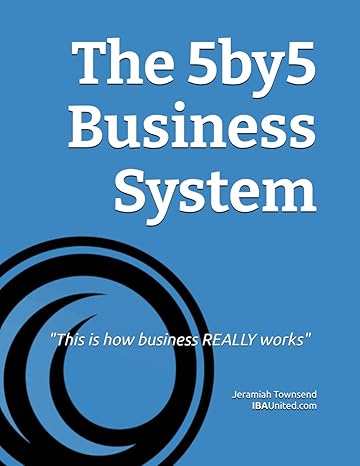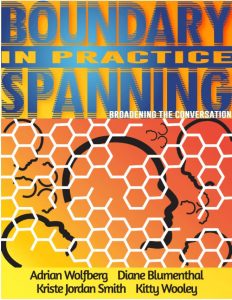Right up front let me advise you, if you are one of the many who don’t do much religion: don’t be thrown off by the subtitle of Christian principles. You can translate that to any value set you like, because the point is that the business has to do more than just make money to satisfy your actual desires, whether they are philanthropic, social or lifestyle. So the method opens up by asking you to confirm to yourself what those ultimate goals are. Without those, the money isn’t enough to get you up every morning, year in and year out, to tend to your creation in the way it needs to survive and thrive.
In addition, the whole 5×5 method depends on backward planning (the author calls it “reverse engineering”) from that vision to ensure that all the company’s activities and people are aligned towards objectives that achieve those value-based goals. The method is called 5×5 because it has 5 basic components (vision, sales, products, team, and operations), and each component has 5 key activities of increasing complexity and impact. These work backward from the vision: first you need operations that deliver effectively, then a team that can operate that way, then products that meet customer needs now and into the future, and last (but by no means least) an effective way of selling those products to customers.

For small businesses, this may be a dramatic shift from the advice given by many internet gurus who advocate selling first and then “faking it until you make it”, i.e., kluging together a barely acceptable product to generate the funds to continue refining the offerings. But it is not an advocation of the paralysis by analysis (or complete chaos) that always follows when attempting to introduce highly-complex changes. Instead, the method calls for having the end goal in mind but taking one next step at a time towards to those goals.
Once you get past the value discussion, the remainder of the book contains action steps and tips that you have probably heard before in various training events, but – well, you wouldn’t be reading the book if you had already applied them! The combination of clear common-sense explanations, searingly honest case examples, and the organization of the widely-known truths into a simple, achievable structure may well inspire the reader to do something about it at last. For those few owners actively thinking about when to exit their businesses, if you don’t have these systems in place, you’re not likely to realize much of a sales price, if you are able to sell at all (over 80 percent of owners cannot). Take it in combination with the advice given in “The Business Value Booster System” also reviewed on this site (and published by Caltrop Press). It’s worth giving this approach a shot for the 18-36 months that it will take to get your business system off the ground and eventually get more profits into your pocket.
Here’s a link to the Amazon version: https://www.amazon.com/dp/B0DMWTBYXW

![Strategy OS: Implement an Advanced Business Operating System in Six Simple Steps (Entrepreneur Tools Book 3) by [Steve Preda]](https://m.media-amazon.com/images/I/41QFBEJ7IWL.jpg)
![CorkScrew Solutions: How Great Leaders Solve Impossible Problems (Theory of Constraints Simplified) by [Clarke Ching]](https://m.media-amazon.com/images/I/41hZj5xZCpL.jpg) easy-to-read book is still somewhat esoteric. It is the first one I have found that explains how to use the “thinking clouds” method first presented by Eli Goldratt in his Critical Chain Thinking series. It provides an approach to clarifying the real issues when you are faced with choices to achieve two different, desirable but mutually-exclusive goals. In following Clarke Ching’s advice, you may be able to see alternative formulations of the problem, the pros and cons, or the objectives as you seek to reconcile your dilemma.
easy-to-read book is still somewhat esoteric. It is the first one I have found that explains how to use the “thinking clouds” method first presented by Eli Goldratt in his Critical Chain Thinking series. It provides an approach to clarifying the real issues when you are faced with choices to achieve two different, desirable but mutually-exclusive goals. In following Clarke Ching’s advice, you may be able to see alternative formulations of the problem, the pros and cons, or the objectives as you seek to reconcile your dilemma.![Here's The Deal: Everything You Wish a Lawyer Would Tell You About Buying a Small Business by [Joel Ankney]](https://m.media-amazon.com/images/I/41l6+OnAAWL.jpg)

 This book is an introduction to Kitty Wooley’s “Senior Fellows” initiative to develop and maintain an ongoing network of public servants (loosely defined) who are willing and able to work across organizational and functional lines to improve both public services and the conditions under which they are provided.
This book is an introduction to Kitty Wooley’s “Senior Fellows” initiative to develop and maintain an ongoing network of public servants (loosely defined) who are willing and able to work across organizational and functional lines to improve both public services and the conditions under which they are provided.![The Phoenix Project: A Novel about IT, DevOps, and Helping Your Business Win by [Kim, Gene, Behr, Kevin, Spafford, George]](https://images-na.ssl-images-amazon.com/images/I/51zDZ1s4hCL.jpg)
![Pink Goldfish: Defy Normal, Exploit Imperfection and Captivate Your Customers by [Phelps, Stan, Rendall, David]](https://images-na.ssl-images-amazon.com/images/I/51IG1Lg%2BIKL.jpg) A very easy reading book, packed with real-company examples to prove the points around the idea that you do much better by being very good at what you’re good at than by trying to copy what the most venerated institution is able to afford to do (but usually doesn’t). For a small entity there are plenty enough potential customers to thrive by being great at your core offering and by turning less-effective elements into points of differentiation.
A very easy reading book, packed with real-company examples to prove the points around the idea that you do much better by being very good at what you’re good at than by trying to copy what the most venerated institution is able to afford to do (but usually doesn’t). For a small entity there are plenty enough potential customers to thrive by being great at your core offering and by turning less-effective elements into points of differentiation.